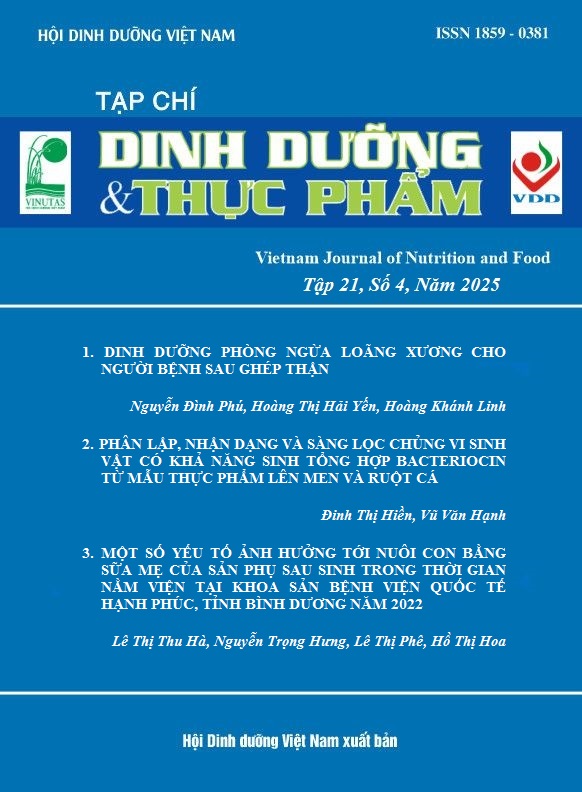DETERMINATION OF THE GLYCEMIC INDEX OF THE READY TO DRINK NUTRITION PRODUCT VÄRNA DIABETES
Main Article Content
Abstract
Aims: To determine the glycemic index (GI) of the ready-to-drink nutritional product Värna Diabetes using the current formula and a newly improved formula.
Methods: An experimental study was conducted involving 12 healthy volunteers who consumed the current formula and 10 who consumed the improved formula. Participants were aged between 18 and 40 years, without diabetes or chronic diseases, medication use, or any physiological conditions that could affect glucose absorption and metabolism. The study followed the methodology for determining GI and the classification of foods according to TCVN 10036:2013 (ISO 26642:2010). Each participant consumed a reference food containing 25 g of glucose and a test food containing an equivalent amount of available carbohydrates. Capillary blood glucose was measured using a personal glucometer at 0, 15, 30, 60, 90, and 120 minutes post-consumption. The GI was calculated as the ratio of the incremental area under the blood glucose response curve (IAUC) for the test food to that of the reference food (glucose).
Results: The glycemic index of the current Värna Diabetes formula was 32 ± 3,6, and that of the improved formula was 26 ± 4,0 both classified as low GI foods.
Conclusion: Both the current and improved formulas of the Värna Diabetes ready-to-drink nutritional product have low glycemic index values (GI≤ 55).
Keywords
Glycemic index, Värna Diabetes, nutritional product, diabetes.
Article Details
References
2. Tạ Thị Lan, Trần Bích Vân, Nguyễn Đình Duyên Hải. Xác định chỉ số đường huyết sản phẩm Diabet Care Platinum. Trung tâm kiểm soát bệnh tật TP.HCM, Báo cáo kết quả nghiên cứu khoa học, 2018.
3. Nguyễn Đình Duyên Hải và cộng sự. Khảo sát chỉ số đường huyết sản phẩm thực phẩm dinh dưỡng y học Dr.Luxia Diabet. Trung tâm Dinh dưỡng TP.HCM, Báo cáo kết quả nghiên cứu khoa học, 2022.
4. Tổng cục Tiêu chuẩn Đo lường chất lượng thẩm định (2013). Thực phẩm- xác định chỉ số Glycaemic (GI) và khuyến nghị cách phân loại thực phẩm TCVN10036:2013 (ISO26642:2010).
5. Livesey G. Health potential of polyols as sugar replacers, with emphasis on low glycemic properties. Nutr Res Rev. 2003;16(2):163-191.
doi: 10.1079/NRR200371.
6. Nitzke D, Czermainski J, Rosa C, Coghetto C, Fernandes SA, Carteri RB. Increasing dietary fiber intake for type 2 diabetes mellitus management: A systematic review. World J Diabetes 2024; 15(5): 1001-1010. Doi: 10.4239/wjd.v15.i5.1001.
7. Abutair AS, Naser IA, Hamed AT. Soluble fibers from psyllium improve glycemic response and body weight among diabetes type 2 patients (randomized control trial). Nutr J. 2016;15(1):86. doi: 10.1186/s12937-016-0207-4.
8. Tsuji H et al. Dietary medium-chain triacylglycerols suppress accumulation of body fat in healthy men and women. J Nutr. 2001;131(11):2853-2859. doi:10.1093/jn/131.11.2853.
9. Nilsson M et al. Glycemia and insulinemia in healthy subjects after lactose-equivalent meals of milk and other food proteins: The role of plasma amino acids and incretins. Am J Clin Nutr. 2004;80(5):1246-1253. doi:10.1093/ajcn/80.5.1246.


